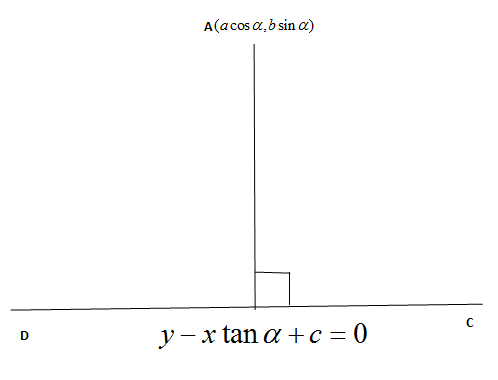
The length of perpendicular from the point \[(a\cos \alpha ,a\sin \alpha )\]upon the straight line \[y = x\tan \alpha + C,c > 0\]is.
A. \[a\cos \alpha \]
B. \[c{\sin ^2}x\]
C. \[c{\sec ^2}x\]
D. \[c{\cos ^2}x\]
Answer
570k+ views
Hint: Perpendicular distance say (d) from a given point \[P({x_1},{y_1})\]to a line \[Ax + By + c = 0\] is given as:
\[ \Rightarrow \dfrac{{|A{x_1} + B{y_1} + C|}}{{\sqrt {{A^2} + {B^2}} }}\]. Use this formula to get the answer.

Complete step-by-step answer:
The given point is P\[(a\cos \alpha ,a\sin \alpha )\].
And our equation of line is\[y = x\tan \alpha + C\].
Perpendicular distance say (d) from a given point\[P({x_1},{y_1})\]to a line \[Ax + By + c = 0\] is given as:
\[ \Rightarrow \dfrac{{|A{x_1} + B{y_1} + C|}}{{\sqrt {{A^2} + {B^2}} }}\].
\[
\Rightarrow d = \dfrac{{|\left( { - \tan \alpha } \right)(a\cos \alpha ) + (1)(a\sin \alpha ) + c|}}{{\sqrt {{{\left( { - \tan \alpha } \right)}^2} + {{(1)}^2}} }} \\
\Rightarrow d = \dfrac{{|\left( { - \dfrac{{\sin \alpha }}{{\cos \alpha }}} \right)(a\cos \alpha ) + (a\sin \alpha ) + c|}}{{\sqrt {1 + {{\tan }^2}\alpha } }} \\
\Rightarrow d = \dfrac{{|( - a\sin \alpha ) + (a\sin \alpha ) + c|}}{{\sqrt {{{\sec }^2}\alpha } }} \\
\Rightarrow d = \dfrac{c}{{\sec \alpha }} \\
\Rightarrow d = c\cos \alpha \\
\]
None of the above options is correct.
The required perpendicular distance=\[c\cos \alpha \].
Note: Working formula to solve such questions:
First simplify the equation of straight line.
Then put the points in our given straight line.
Then put the values in \[\dfrac{{|A{x_1} + B{y_1} + C|}}{{\sqrt {{A^2} + {B^2}} }}\]
Where, \[Ax + By + C = 0\] is the equation of straight line and \[({x_1},{y_1})\] are the points from which perpendicular distance is to be found.
\[ \Rightarrow \dfrac{{|A{x_1} + B{y_1} + C|}}{{\sqrt {{A^2} + {B^2}} }}\]. Use this formula to get the answer.

Complete step-by-step answer:
The given point is P\[(a\cos \alpha ,a\sin \alpha )\].
And our equation of line is\[y = x\tan \alpha + C\].
Perpendicular distance say (d) from a given point\[P({x_1},{y_1})\]to a line \[Ax + By + c = 0\] is given as:
\[ \Rightarrow \dfrac{{|A{x_1} + B{y_1} + C|}}{{\sqrt {{A^2} + {B^2}} }}\].
\[
\Rightarrow d = \dfrac{{|\left( { - \tan \alpha } \right)(a\cos \alpha ) + (1)(a\sin \alpha ) + c|}}{{\sqrt {{{\left( { - \tan \alpha } \right)}^2} + {{(1)}^2}} }} \\
\Rightarrow d = \dfrac{{|\left( { - \dfrac{{\sin \alpha }}{{\cos \alpha }}} \right)(a\cos \alpha ) + (a\sin \alpha ) + c|}}{{\sqrt {1 + {{\tan }^2}\alpha } }} \\
\Rightarrow d = \dfrac{{|( - a\sin \alpha ) + (a\sin \alpha ) + c|}}{{\sqrt {{{\sec }^2}\alpha } }} \\
\Rightarrow d = \dfrac{c}{{\sec \alpha }} \\
\Rightarrow d = c\cos \alpha \\
\]
None of the above options is correct.
The required perpendicular distance=\[c\cos \alpha \].
Note: Working formula to solve such questions:
First simplify the equation of straight line.
Then put the points in our given straight line.
Then put the values in \[\dfrac{{|A{x_1} + B{y_1} + C|}}{{\sqrt {{A^2} + {B^2}} }}\]
Where, \[Ax + By + C = 0\] is the equation of straight line and \[({x_1},{y_1})\] are the points from which perpendicular distance is to be found.
Recently Updated Pages
Master Class 11 Economics: Engaging Questions & Answers for Success

Master Class 11 English: Engaging Questions & Answers for Success

Master Class 11 Social Science: Engaging Questions & Answers for Success

Master Class 11 Biology: Engaging Questions & Answers for Success

Class 11 Question and Answer - Your Ultimate Solutions Guide

Master Class 11 Business Studies: Engaging Questions & Answers for Success

Trending doubts
What is meant by exothermic and endothermic reactions class 11 chemistry CBSE

10 examples of friction in our daily life

One Metric ton is equal to kg A 10000 B 1000 C 100 class 11 physics CBSE

Difference Between Prokaryotic Cells and Eukaryotic Cells

What are Quantum numbers Explain the quantum number class 11 chemistry CBSE

1 Quintal is equal to a 110 kg b 10 kg c 100kg d 1000 class 11 physics CBSE




